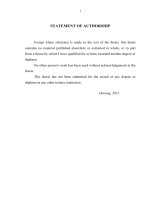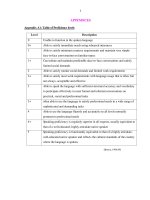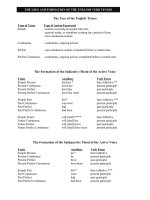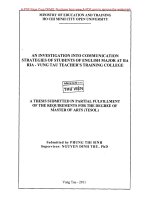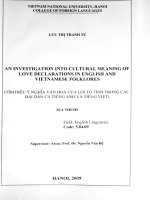An investigation into possible meanings of the english verb come and vietnamese verb về from cognitive perspective through some literary works
Bạn đang xem bản rút gọn của tài liệu. Xem và tải ngay bản đầy đủ của tài liệu tại đây (585.37 KB, 4 trang )
1
VIET NAM NATIONAL UNIVERSITY-HA NOI
UNIVERSITY OF LANGUAGE & INTERNATIONAL STUDIES
FACULTY OF POST – GRADUATE STUDIES
*****************
BÙI THỊ LAN QUỲNH
AN INVESTIGATION INTO POSSIBLE MEANINGS OF
THE ENGLISH VERB ‘COME’ AND VIETNAMESE
VERB ‘VỀ’ FROM COGNITIVE PERSPECTIVE
THROUGH SOME LITERARY WORKS
(NGHIÊN CỨU NHỮNG NÉT NGHĨA CỦA ĐỘNG TỪ ‘COME’ TRONG
TIẾNG ANH VỚI ‘VỀ’ TRONG TIẾNG VIỆT TỪ GÓC ĐỘ TRI NHẬN
QUA MỘT VÀI TÁC PHẨM VĂN HỌC)
M.A. MINOR THESIS
Field: English Linguistics
Code: 602215
HANOI - 2010
2
VIET NAM NATIONAL UNIVERSITY-HA NOI
UNIVERSITY OF LANGUAGE & INTERNATIONAL STUDIES
FACULTY OF POST – GRADUATE STUDIES
*****************
BÙI THỊ LAN QUỲNH
AN INVESTIGATION OF POSSIBLE MEANINGS OF
THE ENGLISH VERB ‘COME’ AND VIETNAMESE
VERB ‘VỀ’ FROM COGNITIVE PERSPECTIVE
THROUGH SOME LITERARY WORKS
(NGHIÊN CỨU NHỮNG NÉT NGHĨA CỦA ĐỘNG TỪ ‘COME’ TRONG
TIẾNG ANH VỚI ‘VỀ’ TRONG TIẾNG VIỆT TỪ GÓC ĐỘ TRI NHẬN
QUA MỘT VÀI TÁC PHẨM VĂN HỌC)
M.A. MINOR THESIS
Field: English Linguistics
Code: 602215
Supervisor: M.A. Nguyễn Thị Thơm Thơm
HANOI - 2010
7
TABLE OF CONTENTS
Abstract........................................................................................................................................i
Acknowledgement…………………………………………………………………………...ii
Abbreviations……………………………………………………………………………......iii
Lists of Tables and Figures…………………………………………………………………iv
Table of
Contents……………………………………………………………………………….v
PART I: INTRODUCTION ..................................................................................................... 1
1.
Rationale ........................................................................................................................... 1
2.
Aims of the study.............................................................................................................. 1
3.
Hypotheses ....................................................................................................................... 2
4.
Scope of the study ............................................................................................................ 2
5.
Method of the study .......................................................................................................... 2
6.
Design of the study ........................................................................................................... 3
PART II: DEVELOPMENT .................................................................................................... 4
CHAPTER I: LITERATURE REVIEW................................................................................. 4
1.1.
Introduction ................................................................................................................... 4
1.2.
Definitions of terms ...................................................................................................... 4
1.2.1. Cognitive linguistics ................................................................................................... 4
1.2.2. Cognitive Semantics ................................................................................................... 5
1.3. Talmy’s theory of lexicalization patterns ......................................................................... 5
1.3.1. Preliminaries............................................................................................................... 5
1.3.2. The Motion Event....................................................................................................... 6
1.3.3. The three-way typology: the verb root ....................................................................... 6
1.3.3.1. Lexicalization pattern: Motion + Co-event ......................................................... 7
1.3.3.3. Lexicalization pattern: Motion + Path ................................................................. 7
1.3.3.4. Lexicalization pattern: Motion + Figure…………………………………….......8
1.3.4. The two-way typology: Path of motion...................................................................... 9
1.4.
Image Schema ............................................................................................................. 10
1.5.
Summary ..................................................................................................................... 10
CHAPTER II: DEICTIC MOTION VERBS........................................................................ 12
2.1.
Deictic motion verbs in English.................................................................................. 12
2.2.
Deictic motion verbs in Vietnamese ........................................................................... 13
CHAPTER 3: APPLYING COGNITIVE SEMANTICS TO INVESTIGATE POSSIBLE
MEANINGS OF THE ENGLISH VERB ‘COME’ AND VIETNAMESE VERB ‘VỀ’ ... 16
3.1. Syntactic features ............................................................................................................ 16
3.2. Semantic features ............................................................................................................ 17
3.2.1. Semantic features of Come....................................................................................... 17
3.2.2. Semantic features of Về ............................................................................................ 19
3.3. Image schema of come and về ........................................................................................ 21
3.4. Typology for deictic motion verb come and về: A comparison...................................... 22
3.4.1. Motion plus Path ...................................................................................................... 23
3.4.2. Motion plus Figure ................................................................................................... 26
3.4.3. Other conflations ...................................................................................................... 28
CHAPTER 4: THE STUDY ................................................................................................... 28
4.1. Introduction .................................................................................................................... 28
4.2. Hypotheses ...................................................................................................................... 28
4.3. Data collection ................................................................................................................ 28
4.4. Data analysis ................................................................................................................... 28
4.5. Results and Discussion ................................................................................................... 30
4.5.1. Hypothesis I.............................................................................................................. 30
4.5.2. Hypothesis II ............................................................................................................ 34
4.6. Concluding remarks ........................................................................................................ 37
PART III: CONCLUSION ..................................................................................................... 38
1. Recapitulation .................................................................................................................... 38
2. Implications for linguistic research, English language teaching and translation ............... 39
3. Limitations ......................................................................................................................... 40
4. Recommendations for further research .............................................................................. 40
REFERENCES
APPENDIXES
